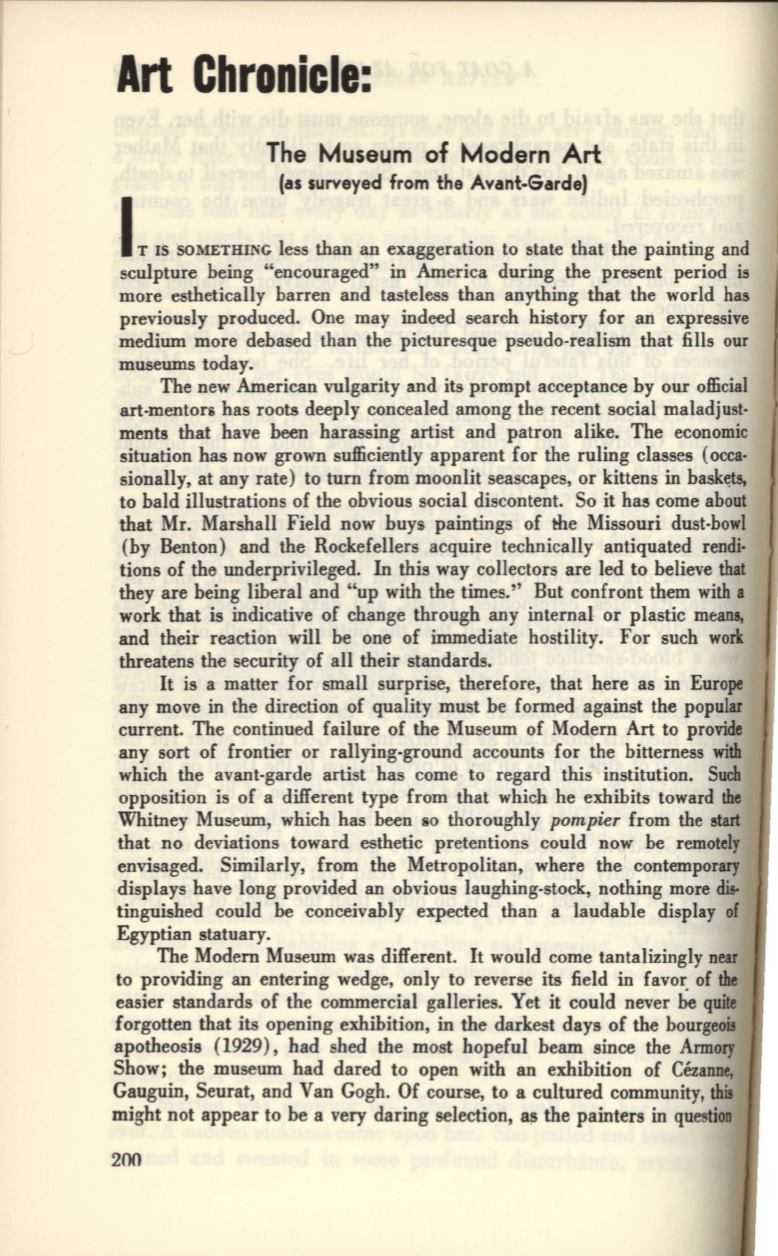
Art Chronicle:
The Museum of Modern Art
(as surveyed from the Avant-Garde)
I
T
IS
SOMETHING )""
thon an exau,,.'ion to ,'a" that th' painting and
sculpture being "encouraged" in America during the present period is
more esthetically barren and tasteless than anything that the world has
previously produced. One may indeed search history for an expressive
medium more debased than the picturesque pseudo-realism that fills our
museums today.
The new American vulgarity and its prompt acceptance by our official
art-mentors has roots deeply concealed among the recent social maladjust–
ments that have been harassing artist and patron alike. The economic
situation has now grown sufficiently apparent for the ruling classes (occa–
sionally, at any rate) to turn from moonlit seascapes, or kittens in
bask~
to bald illustrations of the obvious social discontent. So it has come about
that Mr. Marshall Field now buys paintings of the Missouri dust-bowl
(by Benton) and the Rockefellers acquire technically antiquated rendi·
tions of the underprivileged. In this way collectors are led to believe that
they are being liberal and "up with the times." But confront them with a
work that is indicative of change through any internal or plastic means,
and their reaction will be one of immediate hostility. For such work
threatens the security of all their standards.
It is a matter for small surprise, therefore, that here as in Europe
any move in the direction of quality must be formed against the popular
current_ The continued failure of the Museum of Modern Art to provide
any sort of frontier or rallying-ground accounts for the bitterness
with
which the avant-garde artist has come to regard this institution. Such
opposition is of a different type from that which he exhibits toward
the
Whitney Museum, which has been
80
thoroughly
pompier
from the start
that no deviations toward esthetic pretentions could now be remotely
envisaged. Similarly, from the Metropolitan, where the contemporary
displays have long provided an obvious laughing-stock, nothing more dis–
tinguished could be
~onceivably
expected than a laudable display of
Egyptian statuary.
The Modern Museum was different. It would come tantalizingly near
to providing an entering wedge, only to reverse its field in favor. of
the
easier standards of the commercial galleries. Yet it could never
be
quite
forgotten that its opening exhibition, in the darkest days of the bourgeois
apotheosis (1929), had shed the most hopeful beam since the Armory
Show; the museum had dared to open with an exhibition of
Cezanne,
Gauguin, Seurat, and Van Gogh. Of course, to a cultured community, this
might not appear to be a very daring selection, al> the painters in questioD
200


